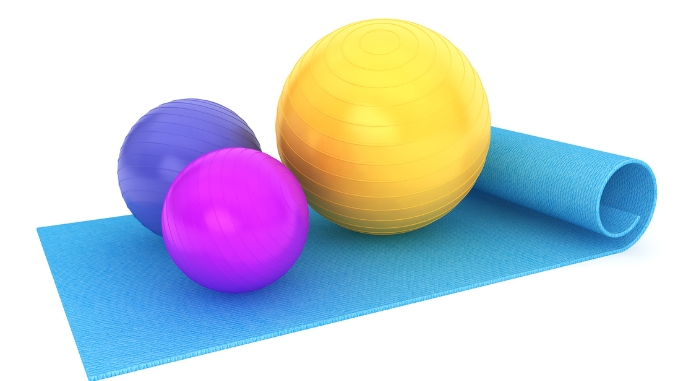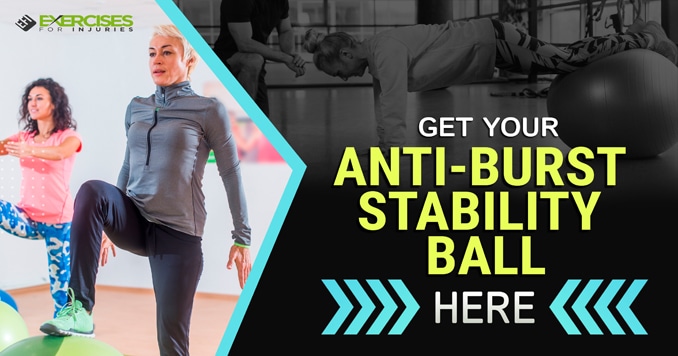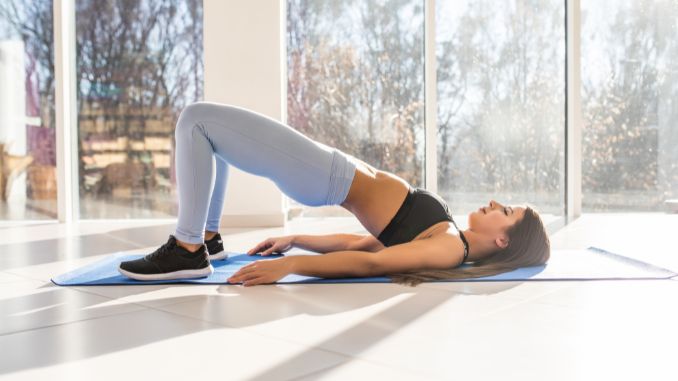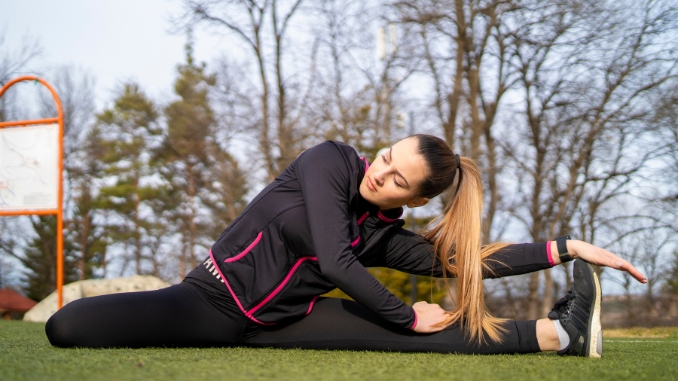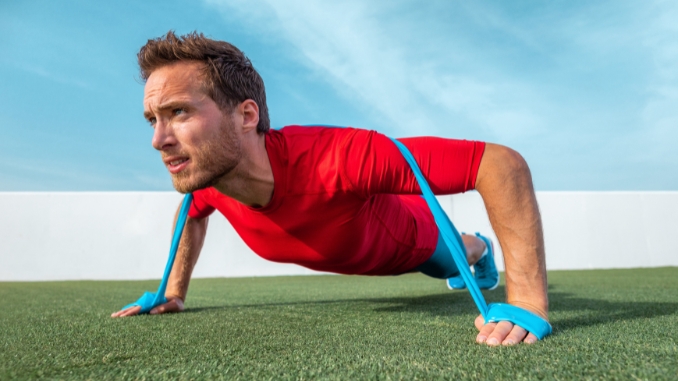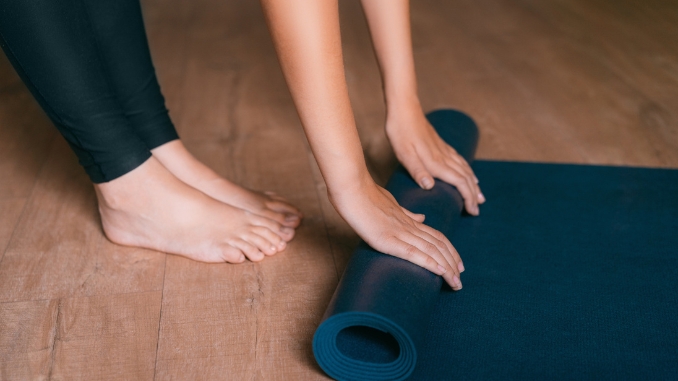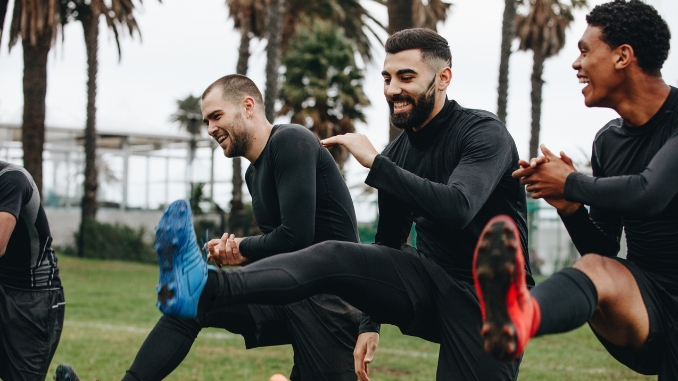Including an exercise ball in your workout routine can be integral to changing how you engage your muscles and improve your overall fitness. This flexible fitness tool introduces an element of instability, requiring your body to constantly adjust and stabilize while performing exercises that effectively engage core muscles.
Its dynamic nature challenges new and experienced fitness enthusiasts, promoting improved coordination and posture. Whether used for strength training, stretching, or as a stability chair, the exercise ball transforms ordinary routines into dynamic, engaging workouts, taking your fitness journey to a whole new level.
Benefits of Using an Exercise ball
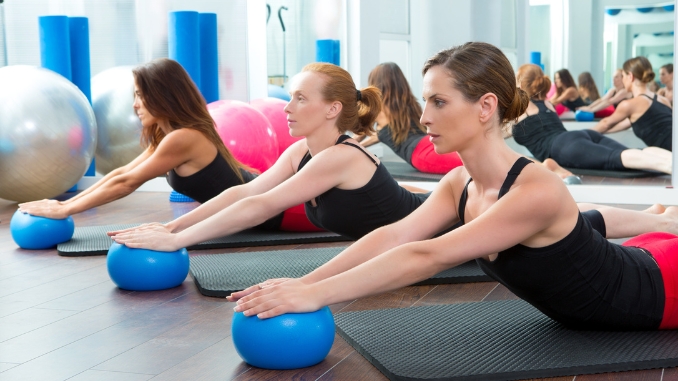
In addition to targeting various muscle groups and simultaneously promoting balance, flexibility, and strength, from simple core workouts to full-body exercises, there are also other benefits to using exercise balls.
- Core Strength: Use an exercise ball to engage the core muscles to maintain balance. This will strengthen your abdomen and lower back muscles, contributing to overall core stability.
- Improves Posture: Proper posture is required to maintain balance while sitting on an exercise ball. This can improve posture in daily activities by encouraging you to sit up straight and align your spine.
- Versatility: Exercise balls are adaptable. It can be used for a variety of exercises that target various muscle groups. The ball adds a factor of instability that challenges your muscles in new ways, from core exercises to full-body workouts.
- Enhances Flexibility: Incorporating an exercise ball into your routine allows for a greater range of motion in certain exercises, which promotes flexibility and joint mobility.
- Balance and Coordination: The unstable surface of the exercise ball requires your body to constantly make small adjustments, improving balance and coordination over time.
Rehabilitation: Physical therapists frequently use exercise balls in rehabilitation programs. They can assist your recovery from injuries, improve your stability, and gain strength.
Low Impact: Exercises performed on an exercise ball are low-impact, making them appropriate for people with joint issues or those seeking a gentler workout option.
Remember to choose the right size of the exercise ball based on height, and always use proper form to avoid injury. So, whether you’re a fitness enthusiast or someone recovering from an injury, an exercise ball can be a beneficial tool in enhancing your exercise routine.
Types of Exercise Balls
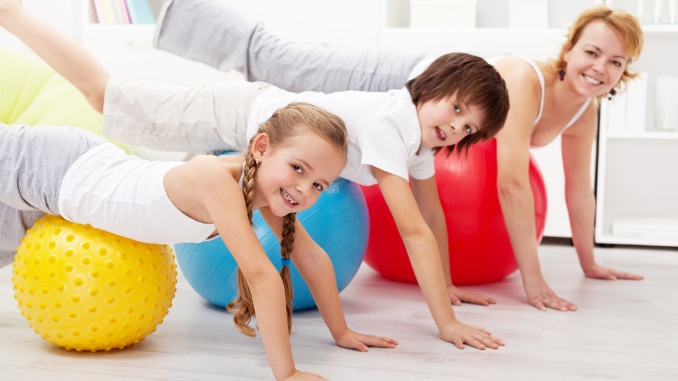
Stability Balls
This standard quality exercise ball is employed for core exercises, stability training, and full-body workouts. Its versatile design targets multiple muscle groups, making it an essential tool for those seeking comprehensive fitness and balance improvement.
Medicine Ball
A smaller, weighted ball crafted for strength and power training, the medicine ball is frequently utilized in dynamic exercises.
Its compact size and substantial weight make it a valuable asset for enhancing physical strength and performance.
Burst Resistant Ball
Specifically engineered to deflate slowly if punctured, the burst-resistant ball prioritizes safety during workouts.
This design feature ensures a gradual release of air, minimizing the risk of injury and offering users a secure exercise experience.
Peanut Ball
Shaped like a peanut. This stability ball is commonly used for back and core exercises in physical therapy.
Its unique design provides stability and support, making it an effective tool for targeted muscle engagement in rehabilitation settings.
Gym Ball Chair
This chair operates as both a chair and a fitness tool. It promotes active sitting and acontributes to improved posture also.
This dual-purpose design integrates comfort with functionality, allowing individuals to engage their core muscles while maintaining proper alignment during extended periods of sitting.
Yoga Ball
Also known as an exercise or stability ball. A yoga ball is a large inflatable ball used in various fitness routines.
It is particularly popular for enhancing core strength, stability, and balance during exercises. Yoga balls engage different muscle groups and promote flexibility, making them versatile tools in both fitness and rehabilitation settings.
Birthing Ball
A birthing ball, also known as a pregnancy or exercise ball, is a large inflatable ball designed for use during pregnancy and childbirth.
It is a versatile tool to support various exercises and positions that can alleviate discomfort and promote relaxation for expectant mothers. The gentle movements and positions facilitated by the birthing ball are often recommended to help prepare for labor and improve overall comfort during pregnancy.
Sizes of Exercise Ball
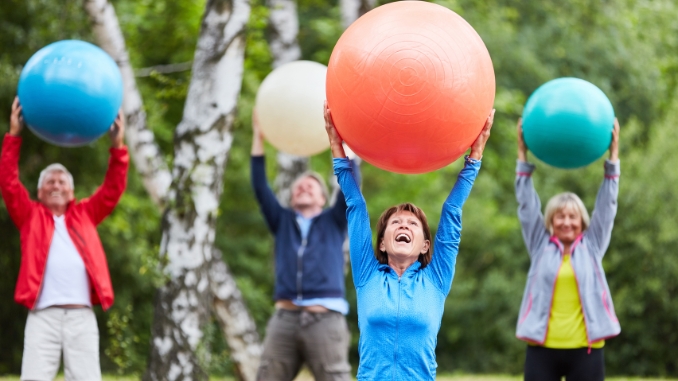
- 45 cm: Suitable for individuals under 5 feet tall
- 55 cm: Ideal for people between 5 to 5.5 feet tall
- 65 cm: Recommended for those between 5.5 to 6 feet tall
- 75 cm: Suitable for individuals over 6 feet tall
- 85 cm: Used for specific exercises and individuals over 6.5 feet tall
Tips for Choosing the Right Exercise Ball
- Size Matters: Select the appropriate size based on your height. Check the manufacturer’s guidelines for sizing recommendations.
- Weight Capacity: To guarantee stability and safety, ensure that the exercise ball's static weight capacity exceeds your body weight.
- Material Quality: For added safety, choose a ball made of anti-burst material. If punctured, it should deflate slowly rather than rapidly.
- Texture: Opt for a ball with a non-slip and textured surface to provide better grip during exercises.
- Inflation Pump: Consider purchasing an inflation pump to achieve the correct inflation level easily.
Maintenance and Care of an Exercise Ball
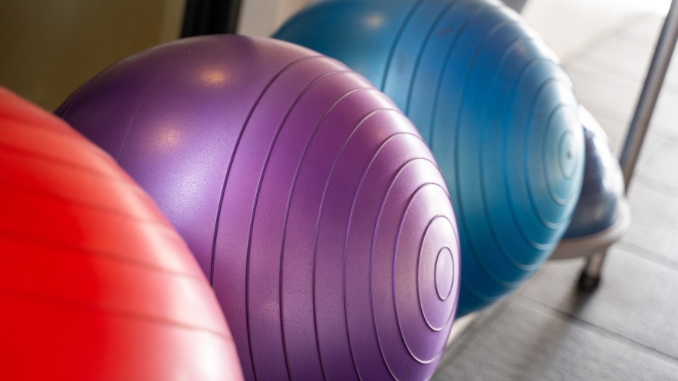
- Regular Inspection: Before each use, inspect the ball for any signs of wear, punctures, or damage.
- Clean Surface: Wipe the surface of the ball with a clean cloth damped with cool water to remove any dirt or sweat.
- Storage: To prevent your exercise ball from deteriorating, keep it in a cool, dry area and avoid direct sunlight.
- Proper Inflation: To ensure optimal performance, check and maintain the correct inflation level regularly.
- Avoid Sharp Objects: Keep the ball away from anything sharp that could puncture or damage it.
5 Game-Changing Exercises: Elevate Your Routine with the Exercise Ball
1. Leg Squeeze
Begin in an upright standing position with your feet hip-width apart, while maintaining good alignment with your head, shoulders, hips, and legs. Place a stability ball between your knees. Engage your core and thigh muscles. Squeeze the ball in with your legs, hold it for a few seconds and release the squeeze. Repeat this movement in 10 repetitions.
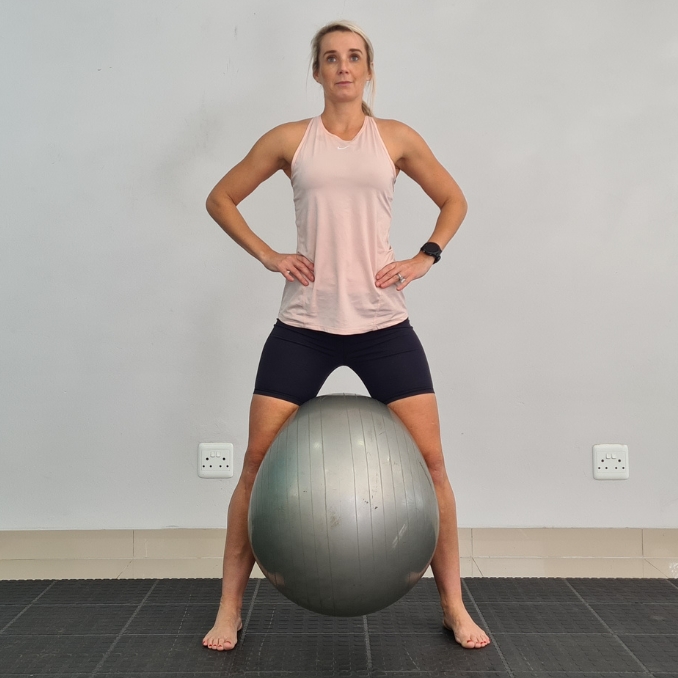
2. Plank
Move into a four-point position, with your knees below your hips and your hands beneath your shoulders. Place a stability ball under your chest and tighten your core.
Move into a full plank position, maintaining proper alignment with your head, shoulders, hips, and toes. Hold this position for several deep belly breaths, in through your nose and then out through your mouth. Relax and return to the starting position. Repeat the movement.
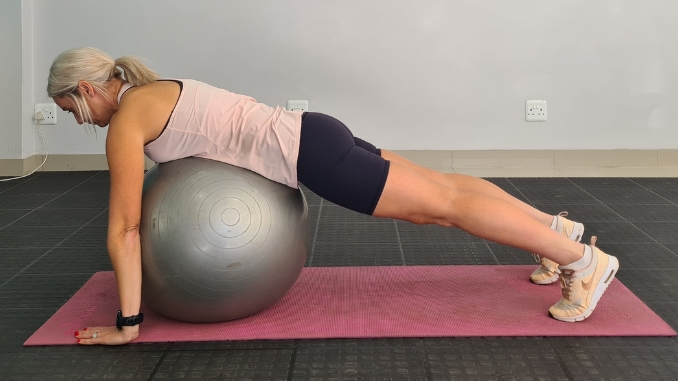
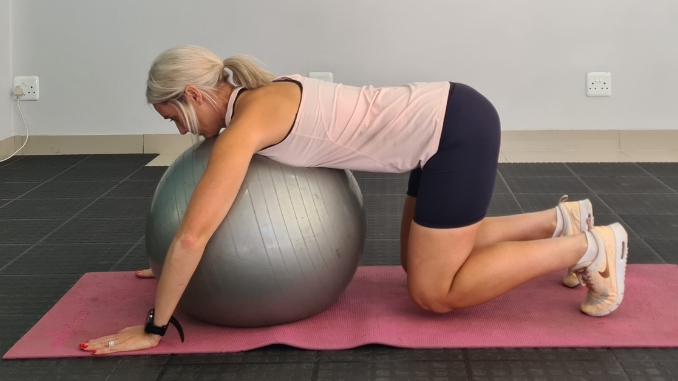
3. Hip Rotation
Sit upright on the stability ball with your feet shoulder-width apart, while maintaining good alignment with your head, shoulders, hips. Place both hands on your hips. Engage your core and maintain your balance. Gently rock your hips from side to side and forward to backward, start with a slower motion. As you become comfortable, increase the range of motion. Repeat the sequence of movements.
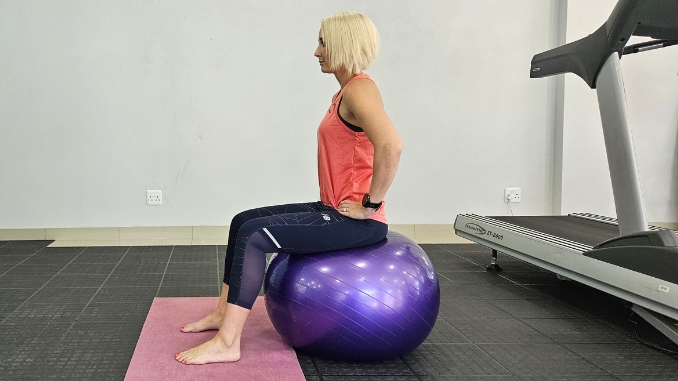
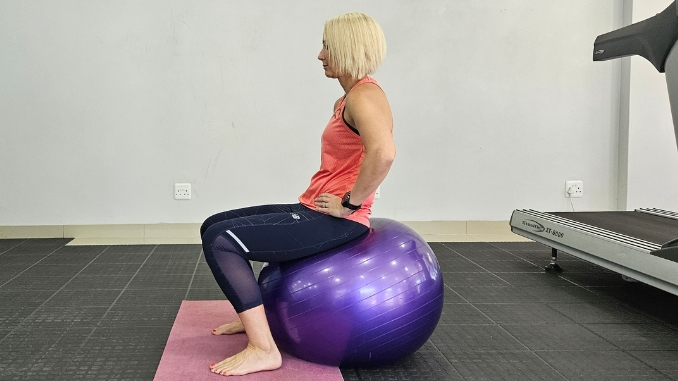
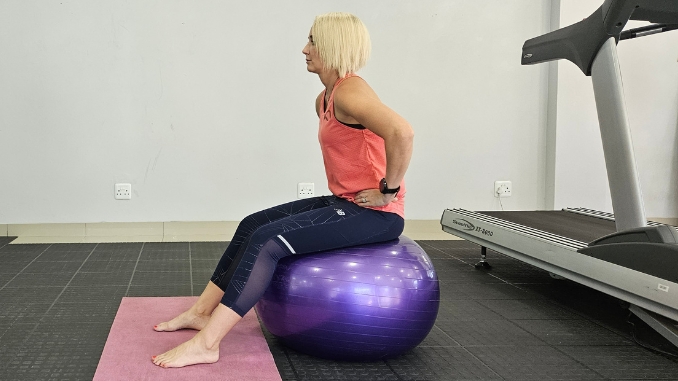
4. Twist with Ball
Begin in an upright standing position with your feet shoulder-width apart, while maintaining good alignment with your head, shoulders, hips and legs. Hold the ball with both hands, extend your arms and lift the ball at chest height.
Contract your core and twist your upper body to one side while holding the ball. Hold this position for several deep belly breaths, in through your nose and out through your mouth. Return to the starting position and repeat the movement on the opposite side.
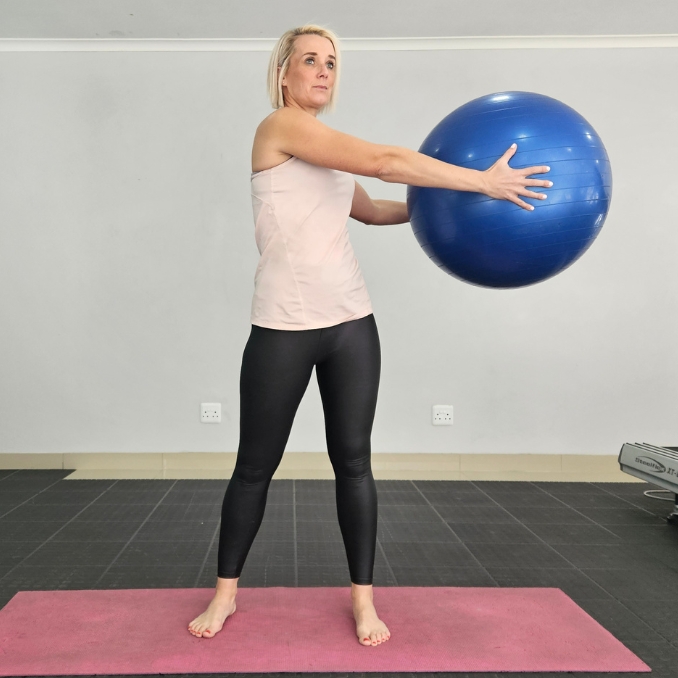
5. Bouncing
Begin in an upright sitting position on the stability ball with your feet flat on the floor. Maintain good alignment with your head, shoulders, and hips. Engage your core. Slowly bounce up and down. To intensify this exercise, do the side-bend stretch. Raise your arms up, and slightly bend your upper to the side. Do this movement with the opposite side, alternately. Repeat the movement.
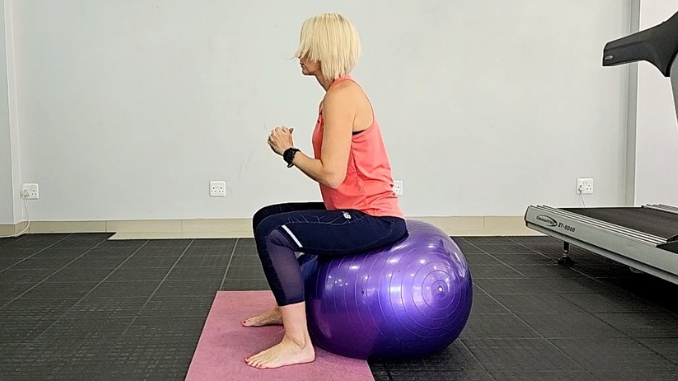
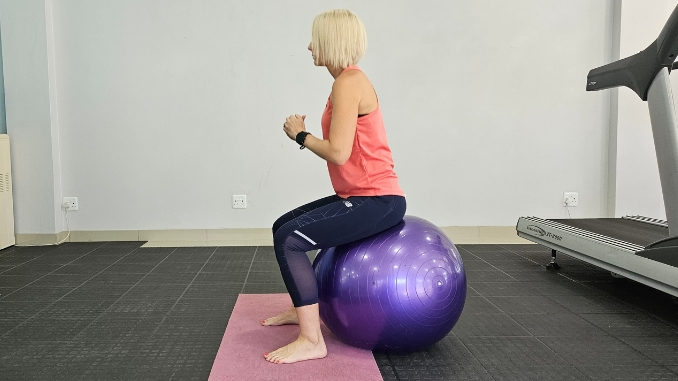
Five Top-Rated Exercise Balls on Amazon for Your Home Workouts
1. Trideer Yoga Ball Exercise Ball
This gym ball has 5 different sizes and is suitable for various exercises, including yoga, balance, and stability. It can also be used as an office chair. It includes a quick pump for easy inflation.
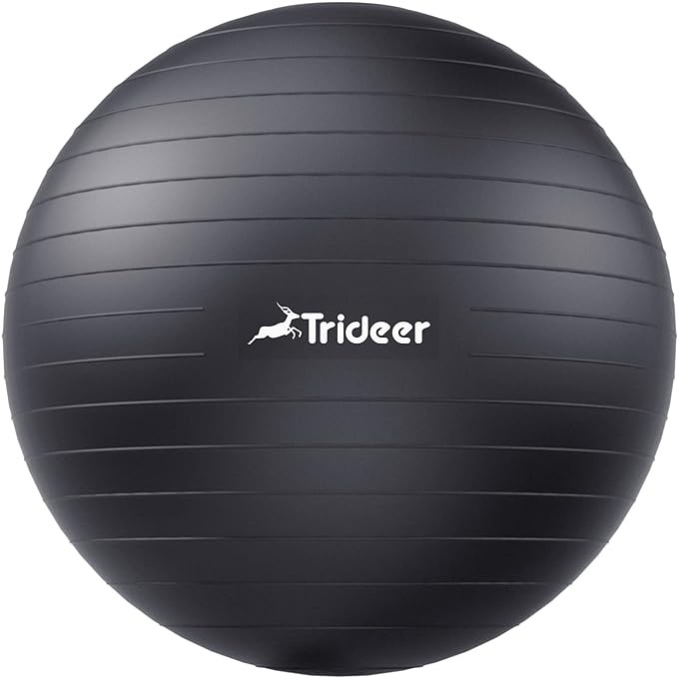
2. Signature Fitness Anti-Burst Exercise Ball
With a 2,000-pound capacity, this anti-burst and slip-resistant exercise ball is great for yoga, fitness, and birthing exercises. It comes in multiple color options.
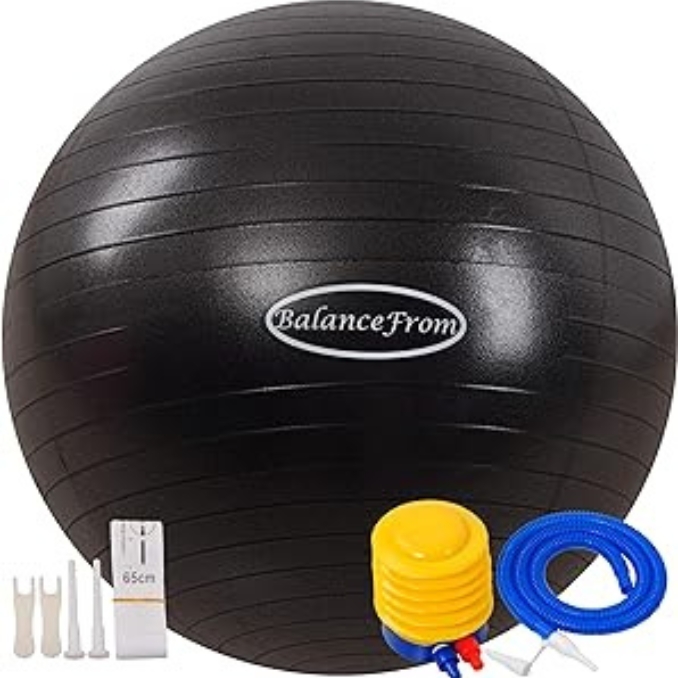
3. ProBody Pilates Ball
Designed for stability and balance, this large gym-grade birthing ball is ideal for pregnancy, workouts, and physical therapy. It includes a pump and comes in various sizes.
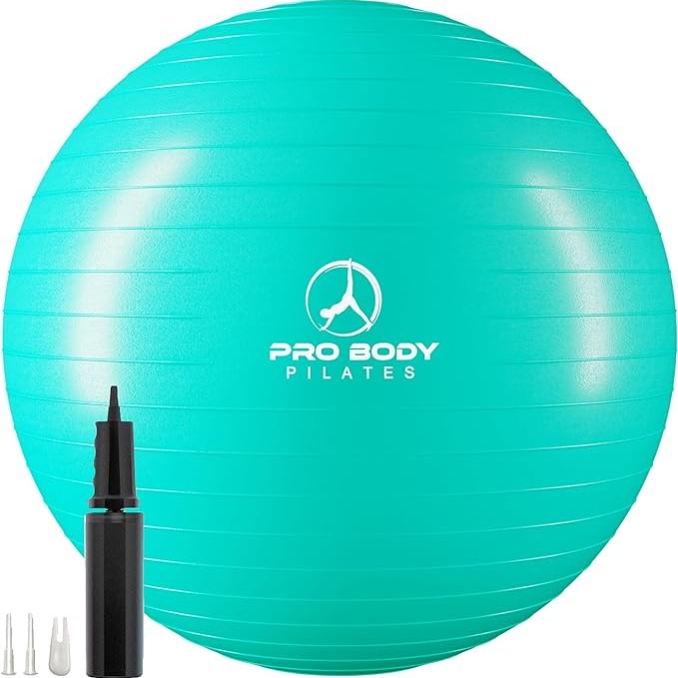
4. Trideer Pilates Ball 9 Inch Core Ball
This small exercise ball is perfect for core training, stretching, and physical therapy. It’s available in multiple colors and includes an exercise guide.
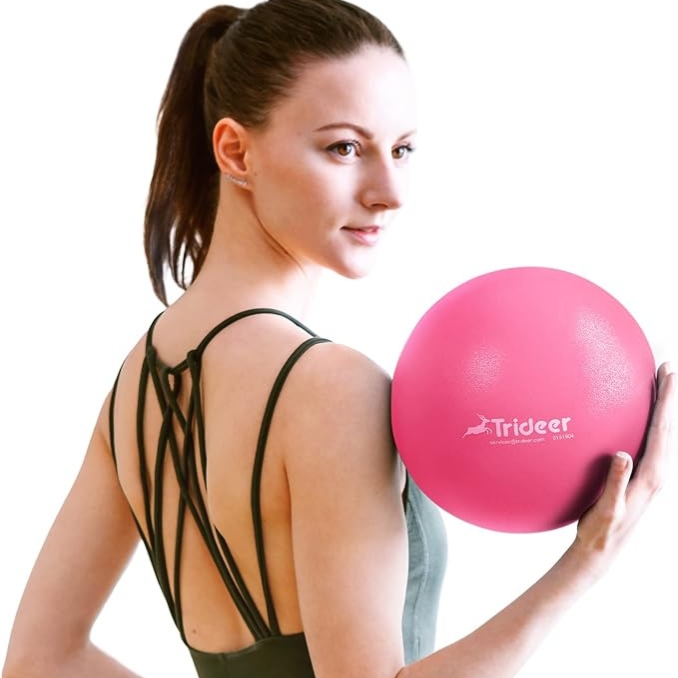
5. THERABAND Exercise Ball
This professional series stability ball improves posture balance, specifically designed for athletes between 4’7" to 5’0" tall. It can also be used for yoga and Pilates.
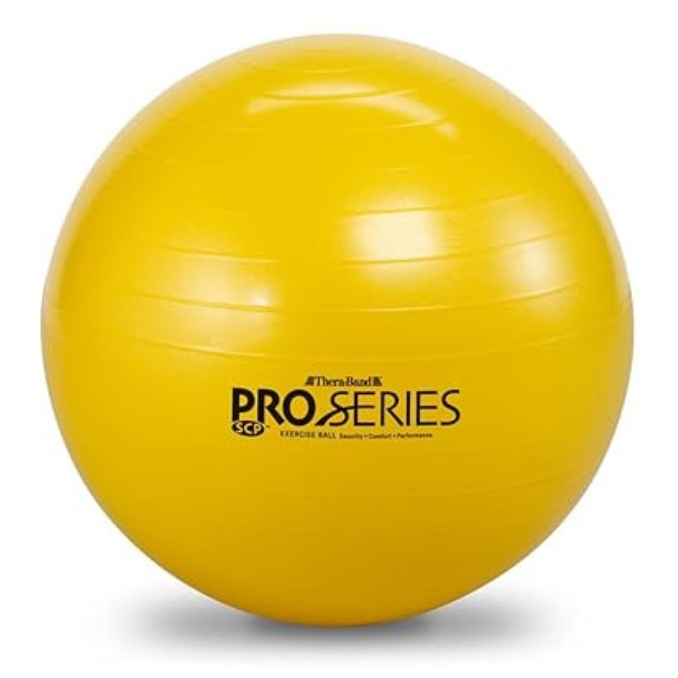
Technique and Proper Form When Using an Exercise Ball
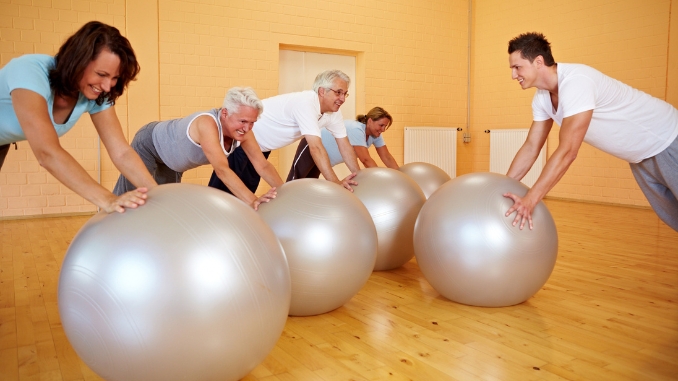
- Inflation: Ensure the exercise ball is properly inflated according to the size recommended for your height. Enhance your exercise routine by ensuring optimal inflation using a hand pump for your quality exercise ball, promoting improved balance, strength, and flexibility in your fitness journey.
- Sitting Posture: When using the ball as a chair, sit on the ball with your feet flat on the floor, maintaining a neutral spine and engaged core.
- Exercise Surface: Choose a clear, open area to prevent collisions or obstacles during exercises.
- Warm-Up: Begin with a light exercise to prepare your muscles to stabilize your body on the ball.
- Core engagement: Maintain constant engagement of your core muscles for your body's stability on the ball.
- Balanced Position: Keep your weight evenly distributed on the ball, avoiding excessive leaning in any direction.
- Neutral Spine: Maintain neutral spine alignment during exercises to prevent strain on the back.
- Gradual Progression: Begin with easy exercises and move on to harder ones as you get stronger and steadier.
- Breathing: Breathe steadily and avoid holding your breath during exercises.
- Use support: Initially, use a stable surface (wall or partner) for support until you feel confident with the ball.
- Correct Size: Choose the right size of the exercise ball based on your height for optimal effectiveness.
- Careful Dismount: Stand up slowly to avoid dizziness or losing balance when getting off the ball.
Remember, maintaining proper form is essential to maximize the benefits of exercise ball workouts and minimize the risk of injury.
Frequently Asked Questions

1. What is an exercise ball used for?
An exercise ball is a versatile fitness tool utilized for various purposes, including core exercises that target abdominal muscles and promote overall core strength.
It is commonly employed in stability training to enhance balance and coordination, providing an unstable surface that engages multiple muscle groups. Full-body workouts often incorporate the exercise ball to improve strength and flexibility across various body regions.
Additionally, the ball is instrumental in performing balance exercises, helping individuals refine their stability and proprioception. Overall, the exercise ball offers a dynamic and effective means of engaging the body in diverse fitness routines.
2. Is a gym ball good for belly fat?
While using a gym ball alone may not specifically target belly fat, incorporating it into a comprehensive fitness routine that includes core exercises can contribute to overall fat loss.
Regular exercise, including workouts with a gym ball, helps burn fats and promotes a healthier body composition. Combining cardiovascular exercises, a balanced diet, and strength training is generally more effective for reducing belly fat and achieving overall fitness goals.
3. Who should not use an exercise ball?
Individuals with certain medical conditions or limitations should exercise caution or avoid using an exercise ball.
Pregnant women in their later stages of pregnancy, individuals with back problems or severe balance issues, and those with certain orthopedic conditions should consult with a healthcare professional before incorporating an exercise ball into their fitness routine.
Individuals must assess their health status and seek guidance to ensure that using an exercise ball is appropriate and safe for their specific circumstances.
4. Do exercise balls really work?
Yes, exercise balls can be effective tools for various fitness goals. During workouts, they engage multiple muscle groups, particularly the core, promoting strength, balance, and flexibility.
Incorporating exercises with an exercise ball into a well-rounded fitness routine can contribute to overall physical fitness and well-being. However, the effectiveness depends on consistent use, proper form, and integration with a comprehensive exercise and nutrition plan tailored to individual goals.
5. What are the benefits of the ball pass exercise?
The ball pass exercise, where you lie on your back and pass a fitness ball between your hands and legs, offers several benefits.
It engages and strengthens the abdominal muscles, particularly the rectus abdominis, and obliques, contributing to improved core stability. This exercise also enhances coordination and balance as you move your limbs in a controlled manner.
Additionally, the ball pass exercise promotes flexibility in the hip flexors and hamstrings, fostering better overall mobility. Including it in your workout routine can help target multiple muscle groups simultaneously. This makes it an efficient choice for full-body engagement and fitness.
Conclusion: The Versatility and Effectiveness of Exercise Balls in Enhancing Workout Routines
The quality exercise ball emerges as a versatile tool, significantly enhancing the effectiveness of your workout routines. Its dynamic design, engaging multiple muscle groups, promotes improved balance, strength, and flexibility.
Whether focusing on core fitness with ab exercises or balance exercises or seeking enhanced stability in full-body workouts, the exercise ball caters to all fitness levels. Its positive impact on posture and coordination contributes to an overall improved b experience.
The exercise ball is a reliable fitness companion for both beginners seeking stability and seasoned athletes searching for new challenges. Elevate your workouts, embrace variety, and experience the remarkable transformation these simple spheres bring to your fitness journey. Consider incorporating resistance bands for added intensity, and for optimal inflation, utilize foot pumps or hand pumps.
Whether you're training at home or in the gym, the Exercises For Injuries Stability Ball is an essential workout tool. So check out this Anti-Burst Stability Ball now!

